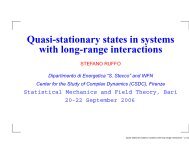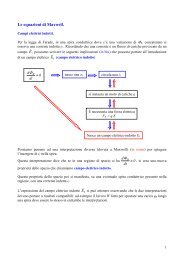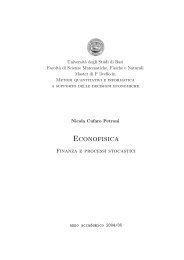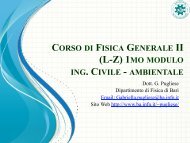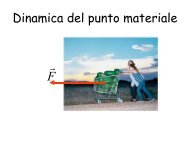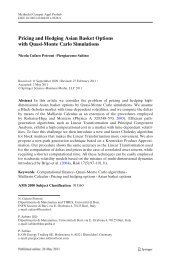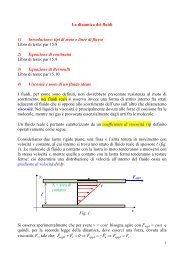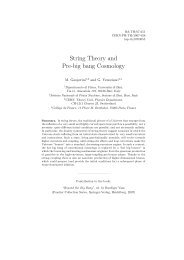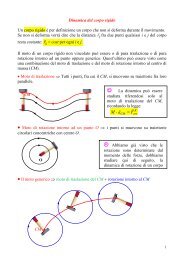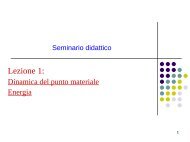Phase ordering in chaotic map lattices with additive noise - Infn
Phase ordering in chaotic map lattices with additive noise - Infn
Phase ordering in chaotic map lattices with additive noise - Infn
- No tags were found...
Create successful ePaper yourself
Turn your PDF publications into a flip-book with our unique Google optimized e-Paper software.
9 July 2001Physics Letters A 285 (2001) 293–300www.elsevier.com/locate/pla<strong>Phase</strong> <strong>order<strong>in</strong>g</strong> <strong>in</strong> <strong>chaotic</strong> <strong>map</strong> <strong>lattices</strong> <strong>with</strong> <strong>additive</strong> <strong>noise</strong>Leonardo Angel<strong>in</strong>i ∗ , Mario Pellicoro, Sebastiano StramagliaDipartimento Interateneo di Fisica, Istituto Nazionale di Fisica Nucleare, Sezione di Bari, via Amendola 173, 70126 Bari, ItalyReceived 26 March 2001; received <strong>in</strong> revised form 18 May 2001; accepted 21 May 2001Communicated by A.P. FordyAbstractWe present some result about phase separation <strong>in</strong> coupled <strong>map</strong> <strong>lattices</strong> <strong>with</strong> <strong>additive</strong> <strong>noise</strong>. We show that <strong>additive</strong> <strong>noise</strong> actsas an <strong>order<strong>in</strong>g</strong> agent <strong>in</strong> this class of systems. In particular, <strong>in</strong> the weak coupl<strong>in</strong>g region, a suitable quantity of <strong>noise</strong> leads tocomplete phase separation. Extrapolat<strong>in</strong>g our results at small coupl<strong>in</strong>g, we deduce that this phenomenon could take place also<strong>in</strong> the limit of zero coupl<strong>in</strong>g. © 2001 Elsevier Science B.V. All rights reserved.PACS: 05.45.Ra; 05.70.Ln; 05.50.+q; 82.20.MjKeywords: Chaos; Noise; <strong>Phase</strong> separation; Coupled <strong>map</strong> <strong>lattices</strong>1. IntroductionThe role of <strong>noise</strong> as an <strong>order<strong>in</strong>g</strong> agent has beenbroadly studied <strong>in</strong> recent years <strong>in</strong> the context of bothtemporal and spatiotemporal dynamics. In the temporalcase, that was first considered, external fluctuationswere found to produce and control transitions(known as <strong>noise</strong>-<strong>in</strong>duced transitions) from monostableto bistable stationary distributions <strong>in</strong> a large varietyof physical, chemical and biological systems [1]; thephenomenon of <strong>noise</strong>-<strong>in</strong>duced order <strong>in</strong> <strong>chaotic</strong> systemshas also been analyzed (see, for example, [2]).As far as spatiotemporal systems are concerned, thecomb<strong>in</strong>ed effects of the spatial coupl<strong>in</strong>g and <strong>noise</strong>may produce an ergodicity break<strong>in</strong>g of a bistable state,lead<strong>in</strong>g to phase transitions between spatially homogeneousand heterogeneous phases. Results obta<strong>in</strong>ed <strong>in</strong>* Correspond<strong>in</strong>g author.E-mail address: angel<strong>in</strong>i@ba.<strong>in</strong>fn.it (L. Angel<strong>in</strong>i).this field <strong>in</strong>clude critical-po<strong>in</strong>t shifts <strong>in</strong> standard modelsof phase transitions [3], pure <strong>noise</strong>-<strong>in</strong>duced phasetransitions [4], stabilization of propagat<strong>in</strong>g fronts[5], and <strong>noise</strong>-driven structures <strong>in</strong> pattern-formationprocesses [6]. In all these cases, the qualitative (andsomewhat counter<strong>in</strong>tuitive) effect of <strong>noise</strong> is to enlargethe doma<strong>in</strong> of existence of the ordered phase <strong>in</strong> the parameterspace.It is the purpose of this Letter to analyse the roleof <strong>additive</strong> <strong>noise</strong> <strong>in</strong> the phase separation of multiphasecoupled <strong>map</strong> <strong>lattices</strong> (CMLs) [7,8]. Coupled<strong>map</strong> <strong>lattices</strong> are networks of <strong>chaotic</strong> elements <strong>in</strong>troducedto <strong>in</strong>vestigate complex dynamical phenomena<strong>in</strong> spatially extended systems. They consists of <strong>chaotic</strong><strong>map</strong>s locally coupled diffusively <strong>with</strong> some coupl<strong>in</strong>gstrength g. In these systems one observes multistabilitythat is the rema<strong>in</strong>der, for small coupl<strong>in</strong>gs, ofthe completely uncoupled case [9]. For large enoughcoupl<strong>in</strong>gs one observes non-trivial collective behavior(NTCB) [10]: collective quantities, such as spatial averages,display the onset of long-range order <strong>in</strong> spite0375-9601/01/$ – see front matter © 2001 Elsevier Science B.V. All rights reserved.PII: S0375-9601(01)00362-0
L. Angel<strong>in</strong>i et al. / Physics Letters A 285 (2001) 293–300 295Fig. 1. The <strong>map</strong> f(x)def<strong>in</strong>ed <strong>in</strong> (4).that is def<strong>in</strong>ed for every x <strong>in</strong> the real axis (see Fig. 1).The <strong>map</strong> here considered is a modified version of the<strong>map</strong> used <strong>in</strong> [11]; the modification is motivated by thefact that, due to the <strong>noise</strong> term ξ i , variables x i (t) arenot constra<strong>in</strong>ed to take value <strong>in</strong> [−1, 1]. Choos<strong>in</strong>g µ =1.9andα = 6, f has two symmetric <strong>chaotic</strong> attractors,one <strong>with</strong> x>0 and the other <strong>with</strong> x0,while the other sites were similarly assigned values<strong>with</strong> x
296 L. Angel<strong>in</strong>i et al. / Physics Letters A 285 (2001) 293–300Fig. 3. The prefactor A calculated by R(t) ∼ A √ t <strong>in</strong> the asymptotictime regime at σ = 0 <strong>in</strong> l<strong>in</strong>ear (a) and log–log (b) plot. Solid l<strong>in</strong>esare best fits lead<strong>in</strong>g to the determ<strong>in</strong>ation of g c through Eq. (2).term<strong>in</strong>ed the value of g c by fitt<strong>in</strong>g both early times (byEq. (1)) and asymptotic (by Eq. (2)) data (see Fig. 3).Our estimates are g c = 0.1652 and w 1 = 0.2260 <strong>in</strong>the first case, and g c = 0.1650 and w 2 = 0.3918 <strong>in</strong>the second one. While obviously, due to the differencebetween Eqs. (1) and (2), the growth exponentdepends on the time scale, the estimate of the criticalcoupl<strong>in</strong>g is essentially the same, thus confirm<strong>in</strong>g theresults of [11]. We also studied at σ = 0 the behaviourof persistence probability p(t). At early times wefound that the exponent θ depends on g accord<strong>in</strong>g tothe follow<strong>in</strong>g law:θ ∼ (g − g c ) w 3,(5)<strong>with</strong> g c = 0.1654. In the asymptotic regime θ is <strong>in</strong>dependenton g and equal to 0.209 (to be compared <strong>with</strong>the value θ = 0.204 reported <strong>in</strong> [11]).A similar behaviour is observed for not vanish<strong>in</strong>gand small <strong>noise</strong> strength σ . For example, <strong>in</strong> Figs. 4(a)and (b) we show, respectively, the fit of z and θ versusg <strong>in</strong> the early times regime, while keep<strong>in</strong>g σ fixedand equal to 0.1. As one can see, data are well fittedby the scal<strong>in</strong>g forms (1) and (5), and the estimated valuesare g c = 0.1628, w = 0.2197 for the z exponent,and g c = 0.1632, w = 0.2024 for the θ exponent [16].The ratio θ/z was estimated at 0.3838. Normal coarsen<strong>in</strong>gwas recovered at late times; also <strong>in</strong> this casethe prefactor A depended on g accord<strong>in</strong>g to (2), giv<strong>in</strong>gthe estimates g c = 0.1629 and w 2 = 0.3904. Weremark that our estimates of the critical coupl<strong>in</strong>g g c ,when non-vanish<strong>in</strong>g and small <strong>noise</strong> is present, areall smaller than the <strong>noise</strong>-free critical value. This factclearly shows that a proper amount of <strong>noise</strong> favoursthe phase separation process of the system.The comparison between the values of g c calculatedby Eq. (1) and the ones calculated by Eq. (2) has beenmade for various values of σ . As already noticed <strong>in</strong>the cases of σ = 0andσ = 0.1, the two estimates co<strong>in</strong>cided<strong>with</strong><strong>in</strong> a reasonable degree of approximation.Therefore <strong>in</strong> the follow<strong>in</strong>g we limit ourselves to reportresults evaluated <strong>in</strong> the early stages of the doma<strong>in</strong>coarsen<strong>in</strong>g process.Let us now consider the region gσ c (g) we got aga<strong>in</strong> power laws for R(t) and p(t),show<strong>in</strong>g that the system separates for large times. Thisbehaviour is shown <strong>in</strong> Fig. 5.
L. Angel<strong>in</strong>i et al. / Physics Letters A 285 (2001) 293–300 297Fig. 4. The estimated scal<strong>in</strong>g exponents at fixed <strong>noise</strong> σ = 0.1: (a) the dependence of the growth exponent z from g <strong>in</strong> l<strong>in</strong>ear and log–log plot,(b) the dependence of the persistence exponent θ from g <strong>in</strong> l<strong>in</strong>ear and log–log scale. Solid l<strong>in</strong>es are best fits lead<strong>in</strong>g to the determ<strong>in</strong>ation of g cand w through the use of (1).We estimated the critical value σ c by fitt<strong>in</strong>g our data<strong>with</strong> the ansatz z ∼ (σ − σ c ) w . In Fig. 6 we show ourdata correspond<strong>in</strong>g to g = 0.16: we evaluated σ c =0.1094 and w = 0.3152. The choice of this ansatzprovided accurate fitt<strong>in</strong>g of data for a large <strong>in</strong>tervalof g lett<strong>in</strong>g us to give a precise measurement of σ c .We were able to measure <strong>in</strong> such a way σ c for ggreater than 0.025; at smaller values of g the dynamicsbecame very slow and we were not able to numericallyextract the exponent z.
298 L. Angel<strong>in</strong>i et al. / Physics Letters A 285 (2001) 293–300Fig. 5. The effect of <strong>additive</strong> <strong>noise</strong> on the time evolution of thedoma<strong>in</strong> size R(t) at g = 0.05. The three curve are relative to σ = 0,σ = 0.06, σ = 0.24.As σ was <strong>in</strong>creased, we found a transition at anothercritical value of the <strong>noise</strong> strength show<strong>in</strong>g that thesystem does not separate beyond this critical σ .Asanexample <strong>in</strong> Fig. 7 we show the exponent z versus σfor g fixed and equal to 0.17. The transition seems tobe discont<strong>in</strong>uous.We repeated this analysis for several values of g.Interpolat<strong>in</strong>g the above described data for the critical<strong>noise</strong> strength, we built the phase diagram for themodel shown <strong>in</strong> Fig. 8. The system separates <strong>in</strong> theshaded area, that is it tends asymptotically to completephase <strong>order<strong>in</strong>g</strong>. Po<strong>in</strong>ts <strong>in</strong> the white area correspondto an asymptotic regime of the system where clustersof the two phases are dynamical but their mean sizerema<strong>in</strong>s constant; only for σ = 0 one has blockedconfigurations <strong>with</strong> clusters fixed <strong>in</strong> time. Our dataconcern g greater than 0.025, however we extrapolatedFig. 6. The estimated growth exponent z versus σ at fixed coupl<strong>in</strong>gg = 0.16 <strong>in</strong> l<strong>in</strong>ear and log–log scale. Also shown is the best fit <strong>with</strong>the function z ∼ (σ − σ c ) w .the two critical curves towards g = 0. We observe,<strong>in</strong>terest<strong>in</strong>gly, that the extrapolation of the two curvesseem to meet at g = 0; further <strong>in</strong>vestigation is neededto clarify the behavior of the noisy system close tog = 0.4. ConclusionsIn this Letter we have shown that <strong>additive</strong> <strong>noise</strong>acts as an <strong>order<strong>in</strong>g</strong> agent <strong>in</strong> this class of systems, i.e.,for a suitable amount of <strong>noise</strong> the system may ordereven for values of the coupl<strong>in</strong>g strength for which no
L. Angel<strong>in</strong>i et al. / Physics Letters A 285 (2001) 293–300 299Fig. 7. The estimated growth exponent z versus σ at fixed coupl<strong>in</strong>gg = 0.17. z goes abruptly to zero at σ = 1.2 show<strong>in</strong>g that the systemdoes not separate beyond this threshold.Fig. 8. The phase diagram <strong>in</strong> the plane σ –g. The shaded area representsthe parameter region <strong>in</strong> which the system separates asymptotically.separation is observed <strong>in</strong> the absence of the <strong>noise</strong> term.We have also reported some evidence that this mighthold <strong>in</strong> the deep multistability region, i.e., g close tozero. A simple explanation for this behavior is thefollow<strong>in</strong>g. Small values of the spatial coupl<strong>in</strong>g lead, <strong>in</strong>the <strong>noise</strong>-free case, to spatially blocked configurationswhere <strong>in</strong>terfaces between clusters of each phase arestrictly p<strong>in</strong>ned. A proper amount of <strong>noise</strong> makes thesystem cross these barriers thus lead<strong>in</strong>g to completephase separation. We have numerically constructed aphase diagram describ<strong>in</strong>g this behavior. As alreadymentioned, a similar effect was observed <strong>in</strong> <strong>chaotic</strong><strong>map</strong> <strong>lattices</strong> evolv<strong>in</strong>g <strong>with</strong> conserved dynamics, wherewe found that the growth process is favoured bytemperature [13]; <strong>in</strong> the present case the <strong>additive</strong> <strong>noise</strong>plays the role of the thermal <strong>noise</strong>.AcknowledgementsThe authors are grateful to H. Chaté and J. Kockelkorenwhose valuable suggestions improved the presentationof this work.References[1] W. Horsthemke, R. Lefever, Noise-Induced <strong>Phase</strong> Transitions,Spr<strong>in</strong>ger, Berl<strong>in</strong>, 1984.[2] K. Matsumoto, I. Tsuda, J. Stat. Phys. 31 (1983) 87;D.W. Hughes, M.R.E. Proctor, Physica D 46 (1990) 163.[3] C. Van Den Broeck, J.M.R. Parrondo, J. Armero, A. Hernandez-Machado,Phys. Rev. E 49 (1994) 2639;J. Garcia-Ojalvo, J.M. Sancho, Phys. Rev. E 49 (1994) 2769;A. Becker, L. Kramer, Phys. Rev. Lett. 73 (1994) 955;A. Becker, L. Kramer, Physica D 90 (1995) 408.
300 L. Angel<strong>in</strong>i et al. / Physics Letters A 285 (2001) 293–300[4] C. Van Den Broeck, J.M.R. Parrondo, R. Toral, Phys. Rev.Lett. 73 (1994) 3395;C. Van Den Broeck, J.M.R. Parrondo, R. Toral, R. Kawai,Phys. Rev. E 55 (1997) 4084;S.H. Park, S. Kim, Phys. Rev. E 53 (1996) 3425.[5] J. Armero, J.M. Sancho, J. Casademunt, A.M. Lacasta, L.Ramirez-Pisc<strong>in</strong>a, F. Sagues, Phys. Rev. Lett. 76 (1996) 3045.[6] J. Garcia-Ojalvo, A. Hernandez-Machado, J.M. Sancho, Phys.Rev. Lett. 71 (1993) 1542;J.M.R. Parrondo, C. Van Den Broeck, J. Buceta, F.J. de laRubia, Physica A 224 (1996) 153;J. Garcia-Ojalvo, J.M. Sancho, Phys. Rev. E 53 (1996) 5680;G.D. Lythe, Phys. Rev. E 53 (1996) R4271;J. Garcia-Ojalvo, A.M. Lacasta, J.M. Sancho, R. Toral, Europhys.Lett. 42 (1998) 125.[7] A large survey on the argument can be found <strong>in</strong> Proceed<strong>in</strong>gsof the Workshop on Lattice Dynamics, Paris, 21–23 June 1995,Physica D 103 (1997).[8] The evolution of probability densities of coupled <strong>map</strong> <strong>lattices</strong>subjected to the <strong>in</strong>fluence of stochastic perturbation has beendiscussed <strong>in</strong> J. Losson, M.C. Mackey, Phys. Rev. E 52 (1995)1403.[9] R.S. McKay, T.A. Sèpulchre, Physica D 82 (1995) 243;T.A. Sèpulchre, R.S. McKay, Nonl<strong>in</strong>earity 10 (1997) 679;S. Aubry, Physica D 103 (1997) 201.[10] H. Chaté, Int. J. Mod. Phys. B 12 (1998) 299.[11] A. Lemaitre, H. Chaté, Phys. Rev. Lett. 82 (1999) 1140;J. Kockelkoren, A. Lemaitre, H. Chaté, Physica A 288 (2000)326.[12] A.J. Bray, Adv. Phys. 43 (1994) 357.[13] L. Angel<strong>in</strong>i, M. Pellicoro, S. Stramaglia, Phys. Rev. E 60(1999) R5021;J. Kockelkoren, H. Chaté, Phys. Rev. E 62 (2000) 3004.[14] J.D. Gunton, M. San Miguel, P.S. Sanhi, <strong>in</strong>: C. Domb, J.Lebowitz (Eds.), <strong>Phase</strong> Transitions and Critical Phenomena,Vol. 8, Academic Press, London, 1983.[15] D.A. Huse, Phys. Rev. B 34 (1986) 7845;J. Amar, F. Sullivan, R. Mounta<strong>in</strong>, Phys. Rev. B 37 (1988) 196;C. Roland, M. Grant, Phys. Rev. B 39 (1989) 11971;J.F. Marko, G.T. Barkema, Phys. Rev. E 52 (1995) 2522.[16] It is well known that <strong>in</strong> presence of <strong>noise</strong> the persistenceprobability p(t) is characterized by an exponential correctionto the power law: p(t) ∼ e −λt t −θ (see, e.g., B. Derrida,Phys. Rev. E 55 (1997) 3705). We found that for low <strong>noise</strong>level the exponential correction to p(t) was negligible and thepersistence exponent was unambiguously evaluated.



